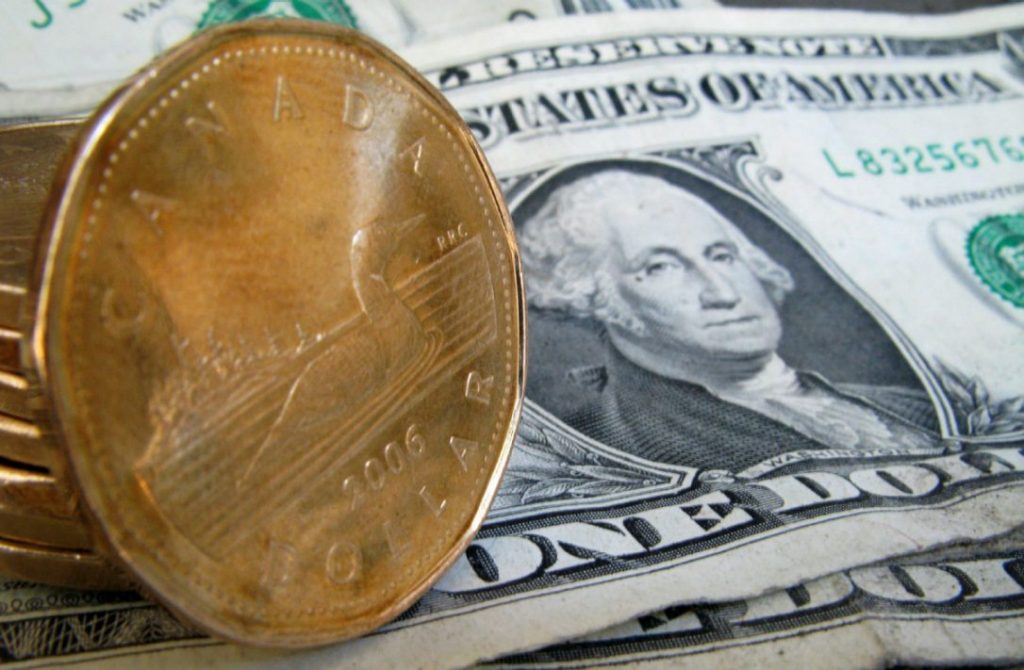
Yesterday’s trade (in GMT terms) saw USD/CAD within the range of 1.3077-1.3270. The pair closed at 1.3080, falling 0.88% compared to Tuesdays close. It has been the 167th drop in the past 348 trading days, a second consecutive one and also the steepest one since July 29th. The major pair has neutralized earlier advance and is now down 0.19% so far during the current month, following a 0.59% gain in August.
At 8:12 GMT today USD/CAD was inching up 0.08% on the day to trade at 1.3091. The pair touched a daily high at 1.3104 during late Asian trade, overshooting the daily R1 level, and a daily low at 1.3048 during the early phase of the Asian trading session. The latter has been a level not seen since September 23rd.
Meanwhile, crude oil futures marked their 97th gain out of the past 202 trading days on September 28th. Yesterday OPEC came to an agreement to cut oil production in the first deal since 2008. Oil output is to be curbed to a range of 32.5 million to 33 million barrels daily from 33.4 million. Saudi Arabia, the largest oil producer worldwide, is to reduce its daily output by 350 000 barrels. Oil for November delivery went up as high as $47.45 per barrel, or a level unseen since September 8th, and closed at $47.05, surging 5.33% compared to Tuesday’s close. As of 8:07 GMT today the commodity was edging down 0.21% to trade at $46.95, after going down as low as $46.83 per barrel earlier. Crude oil prices and CAD valuation tend to be strongly positively correlated.
On Thursday USD/CAD trading may be influenced by the following macroeconomic reports and other events as listed below.
Fundamentals
United States
Fed Speakers
At 9:00 GMT the Fed President for Philadelphia, Patrick Harker, is to take a statement on the economic outlook in front of the Global Interdependence Center Central Banking Series in Dublin.
At 12:50 GMT the Fed President for Atlanta, Dennis Lockhart, is to speak in front of the 2016 Future of Florida Forum in Orlando.
At 14:00 GMT Federal Reserve Board Governor, Jerome Powell, is expected to take a statement before the Community Banking in the 21st Century Conference, which will be hosted by the Federal Reserve Bank of St. Louis.
At 18:00 GMT the Fed President for Minneapolis, Neel Kashkari, is to participate in Town Hall on economic development in Rapid City and surrounding areas.
At 20:00 GMT Fed Chair, Janet Yellen, is expected to speak at the “Banking and the Economy: A Forum for Minority Bankers” conference, which will be hosted by the Federal Reserve Bank of Kansas City.
At 20:15 GMT the Fed President for Kansas City, Esther George, is to speak on “Opportunities and Challenges for the Banking Industry and the Federal Reserve” at the “Banking and the Economy: A Forum for Minority Bankers” conference in Kansas.
Any hints in regard to the Bank’s policy stance or US economic outlook would certainly heighten USD volatility.
Initial, Continuing Jobless Claims
The number of people in the United States, who filed for unemployment assistance for the first time during the business week ended on September 23rd, probably rose to 260 000, according to market consensus, from 252 000 in the preceding week. The latter has been the lowest figure since mid-July.
The 4-week moving average, an indicator lacking seasonal effects, was 258 500, marking a decrease by 2 250 compared to the preceding week’s unrevised average.
The business week, which ended on September 16th, has been the 81st consecutive week, when jobless claims stood below the 300 000 threshold, which suggested a healthy labor market. It has been the longest streak since 1970.
Initial jobless claims number is a short-term indicator, reflecting lay-offs in the country. In case the number of claims met expectations or increased further, this would have a moderate bearish effect on the US dollar.
The number of continuing jobless claims probably rose to the seasonally adjusted 2 130 000 during the business week ended on September 16th, according to the median forecast by experts, from 2 113 000 in the preceding week. The latter represented a decrease by 36 000 compared to the revised up number of claims reported in the week ended on September 2nd. This indicator reflects the actual number of people unemployed and currently receiving unemployment benefits, who filed for unemployment assistance at least two weeks ago.
The US Department of Labor is to release the weekly report at 12:30 GMT.
Gross Domestic Product – final estimate
The final estimate of the US Gross Domestic Product probably pointed to an annualized rate of growth of 1.3% in the second quarter of 2016. If so, it would outpace the 2nd GDP estimate, reported on August 26th. The 2nd estimate came below the preliminary one, because trade contribution to the GDP was lower, while the drop in inventories was sharper than anticipated, according to the Bureau of Economic Analysis.
According to the August 26th report, personal consumption expenditure (PCE) contributed 2.94 percentage points to US growth, as it increased 4.4% in Q2. The preliminary GDP report pointed to a 4.2% PCE growth. Fixed investment shrank 2.5% in the second quarter, slowing down from a 3.2% decrease in the preliminary report. Non-residential investment contracted 0.9% during the period compared to a 2.2% slump in the preliminary estimate, while residential investment fell 7.7%, accelerating from a 6.1% drop in the preliminary release.
Private inventories subtracted 1.26 percentage points from US growth in Q2, as business inventories shrank by USD 12.4 billion compared to a drop by USD 8.1 billion, as reported previously.
International trade added 0.1 percentage points to growth in Q2 compared to a contribution of 0.23 percentage points in the preliminary report. US exports rose 1.2% in the second quarter of 2016 compared to a 1.4% increase in the preliminary release, while US imports went up 0.3% during the period compared to a 0.4% drop reported previously.
In case the final GDP estimate met or even exceeded market expectations, this would have a strong bullish effect on the US dollar. The official report is due out at 12:30 GMT.
Pending Home Sales
The index of pending home sales in the United States probably rose 0.3% in August from a month ago, according to the median estimate by experts. In July, pending home sales surged 1.3%, coming well above market expectations. It has been the fastest monthly increase since April. In July, sales in the Northeast area rose 0.8%, those in the South were also 0.8% more, while sales in the West soared 7.3%. On the other hand, sales in the Midwest region went down 2.9% during the same month.
In annual terms, contracts to buy previously owned homes in the United States were 1.4% more in July, accelerating from a 1.0% increase in the preceding period.
In case pending home sales increased at a faster pace than anticipated in August, this would have a moderate bullish effect on the US dollar. The National Association of Realtor’s (NAR) will report on the official index performance at 14:00 GMT.
Bond Yield Spread
The yield on Canada’s 2-year government bonds went up as high as 0.519% on September 28th, after which it closed at 0.514% to add 1.7 basis points (0.017 percentage point) compared to September 27th.
Meanwhile, the yield on US 2-year government bonds climbed as high as 0.770% on September 28th, or matching the high from a day ago and also being the highest level since September 23rd (0.787%), after which it fell to 0.769% at the close to add 2.3 basis points (0.023 percentage point) compared to September 27th.
The spread between 2-year US and 2-year Canadian bond yields, which reflects the flow of funds in a short term, widened to 0.255% on September 28th from 0.249% on September 27th. The September 28th yield spread has been the largest one since June 8th, when the difference was 0.260%.
Daily, Weekly and Monthly Pivot Levels
By employing the Camarilla calculation method, the daily levels of importance for USD/CAD are presented as follows:
R1 – 1.3098
R2 – 1.3115
R3 (Range Resistance – Sell) – 1.3133
R4 (Long Breakout) – 1.3186
R5 (Breakout Target 1) – 1.3248
R6 (Breakout Target 2) – 1.3273
S1 – 1.3062
S2 – 1.3045
S3 (Range Support – Buy) – 1.3027
S4 (Short Breakout) – 1.2974
S5 (Breakout Target 1) – 1.2912
S6 (Breakout Target 2) – 1.2887
By using the traditional method of calculation, the weekly levels of importance for USD/CAD are presented as follows:
Central Pivot Point – 1.3138
R1 – 1.3275
R2 – 1.3382
R3 – 1.3519
R4 – 1.3657
S1 – 1.3031
S2 – 1.2894
S3 – 1.2787
S4 – 1.2681
In monthly terms, for USD/CAD we have the following pivots:
Central Pivot Point – 1.3024
R1 – 1.3283
R2 – 1.3462
R3 – 1.3721
R4 – 1.3981
S1 – 1.2845
S2 – 1.2586
S3 – 1.2407
S4 – 1.2229





